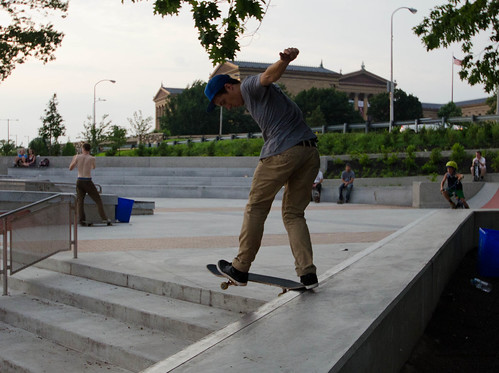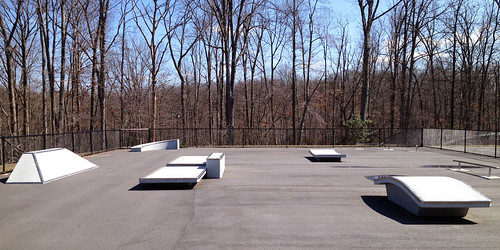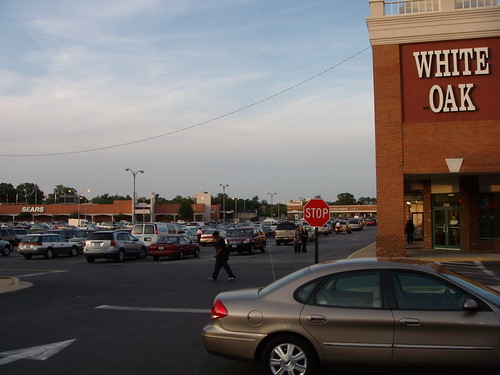Montgomery County's newest skate park in White Oak doesn't have any skaters, due to poor design and an isolated location. A "skate plaza" in the center of the community could give skaters and non-skaters alike a better place to hang out.
The 6,000-square-foot White Oak skate spot, a sort of mini-skate park, is located at at the end of a cul-de-sac off of Lockwood Drive next to a new recreation center, both of which opened in the summer of 2012. Built by the county's Department of Recreation, the skate spot and rec center cost $22 million to build.
The recreation center is usually busy, along with the basketball courts and soccer fields. But I've dropped by the skate park at least dozen times this year, at different times of day, on different days of the week, in winter, spring, and summer. And I've never seen anyone using the skate spot.
"There's no flow"
28-year-old Mike Rious of Colesville visited the skate spot a few times, but he quickly got frustrated with it. Instead, he goes to the Woodside skate spot in Silver Spring or to skate parks in Prince George's County. "It seems as though no skatepark designers or anyone with knowledge of skateboarding was consulted before putting it together," he wrote in an email.
The skate spot is laid out in a way that makes skating almost impossible. I showed some photos of it to my friend Jordan Block, an urban designer and skater who used to work for Franklin's Paine Skatepark Fund, a Philadelphia-based nonprofit that builds skate parks. "There's no flow," he explains.
Normally, skaters would do a trick on one side, then go over to the other side to do another one, building up momentum along the way. In order to do that, you need a clear, straight path with no obstructions. But officials at the Department of Recreation simply dropped pieces like ramps and rails around the site randomly. As a result, Block says, there's always something in the way.
There are also safety issues. The skate park uses prefabricated modular pieces bought off the rack. Skateboarding advocates like Skaters for Public Skateparks discourage using them instead of permanent, concrete pieces, because prefab fixtures often deteriorate faster than permanent ones, and they have exposed seams that can trip and injure skaters.
The skate spot's location is an issue as well. In 2008, county planners noted that 10,000 people live within a 3/4-mile of the site. But the street network is so disconnected that someone living on Carriage House Way, 1000 feet away as the crow flies, would have to travel over a mile to reach the recreation center.
"If I were younger and didn't have my own transportation," wrote Rious, "I would probably still be skating the same places I had before these skate spots were built."
Location, design affect skate spot's use
Compare this to the Woodside skate spot, which the parks department built itself after consulting with local skaters. It also has prefab fixtures, but they were made flush with the ground, reducing tripping hazards. And it's in downtown Silver Spring, a short walk from buses and Metro, places to eat, and other hangouts. Not only is the Woodside skate spot popular with skaters, but it's become such a fixture in the local skating community that they even hold barbeques there.
In its current form, the White Oak skate spot is basically unusable. We could rebuild it to be safer and more attractive to skaters, but the location remains a problem. What if we moved the skate spot to the center of White Oak, instead of the fringe, and made it a destination for skaters and the larger community as well?
Skateboarding is a social activity, often drawing spectators. In downtown Silver Spring, crowds of people formed to watch skaters in Veterans Plaza and on Ellsworth Drive before the county banned it.
Last month, the Montgomery County Planning Board approved the Science Gateway plan, which envisions creating a research and technology hub in White Oak. Planners also envision turning the run-down White Oak Shopping Center at New Hampshire Avenue and Lockwood Drive into a "town center" with shops and housing in taller buildings around a two-acre park.
That park would be a great location for a skate spot: it's across the street from the White Oak Transit Center, an important bus terminal, and is a short distance from thousands of homes and apartments, along with shops, restaurants and the Food and Drug Administration campus. This is an accessible location for skaters, but it's also surrounded by a good mix of uses that could make it a unique public draw.
Communities around the country are building so-called "skate plazas," a cross between a public plaza and a skate park. Franklin's Paine, where my friend used to work, opened a skate plaza in Philadelphia last May called Paine's Park. Designers call it a "not just a skatepark...a park for all that's made to skate."
To the naked eye, Paine's Park looks like an ordinary plaza: there are benches, stairs, ramps, and rails. These all happen to be things skaters like to use, but here they won't get chased away for doing so. And everything's made from cast-in-place concrete, which can take lots of abuse and are still affordable.
Planners often build skate plazas alongside other uses, inviting skaters into the center of the community. Portland is building a big skate plaza in the middle of downtown. The Lafayette Park Skate Plaza in Los Angeles is part of a larger park complex with a library, amphitheatre, and even food carts.
These are spaces you'd go even if you weren't skating, and non-skaters can hang out in skate plazas as well, so long as they don't mind the thumps of skate trucks on concrete. But if skateboarding ceased to exist tomorrow, the community would still have a great public space.
Skate plazas aren't just better for skaters. They create more interesting, attractive public spaces for everyone. It's clear that this thinking went into the White Oak skate spot, which is next to a recreation center, but the design of the skate spot and its isolated location sends a message to skaters that they should be kept out of sight.
Montgomery County wants White Oak to become an innovative urban community. What better way to do so than by embracing the athleticism and spectacle of skateboarding?
 |
| Paine's Park, a "skate plaza" in Philadelphia. Photo by JacGebhardt on Flickr. |
The 6,000-square-foot White Oak skate spot, a sort of mini-skate park, is located at at the end of a cul-de-sac off of Lockwood Drive next to a new recreation center, both of which opened in the summer of 2012. Built by the county's Department of Recreation, the skate spot and rec center cost $22 million to build.
The recreation center is usually busy, along with the basketball courts and soccer fields. But I've dropped by the skate park at least dozen times this year, at different times of day, on different days of the week, in winter, spring, and summer. And I've never seen anyone using the skate spot.
"There's no flow"
28-year-old Mike Rious of Colesville visited the skate spot a few times, but he quickly got frustrated with it. Instead, he goes to the Woodside skate spot in Silver Spring or to skate parks in Prince George's County. "It seems as though no skatepark designers or anyone with knowledge of skateboarding was consulted before putting it together," he wrote in an email.
 |
| The White Oak skate spot is always empty. Photo by the author. |
Normally, skaters would do a trick on one side, then go over to the other side to do another one, building up momentum along the way. In order to do that, you need a clear, straight path with no obstructions. But officials at the Department of Recreation simply dropped pieces like ramps and rails around the site randomly. As a result, Block says, there's always something in the way.
There are also safety issues. The skate park uses prefabricated modular pieces bought off the rack. Skateboarding advocates like Skaters for Public Skateparks discourage using them instead of permanent, concrete pieces, because prefab fixtures often deteriorate faster than permanent ones, and they have exposed seams that can trip and injure skaters.
The skate spot's location is an issue as well. In 2008, county planners noted that 10,000 people live within a 3/4-mile of the site. But the street network is so disconnected that someone living on Carriage House Way, 1000 feet away as the crow flies, would have to travel over a mile to reach the recreation center.
"If I were younger and didn't have my own transportation," wrote Rious, "I would probably still be skating the same places I had before these skate spots were built."
Location, design affect skate spot's use
Compare this to the Woodside skate spot, which the parks department built itself after consulting with local skaters. It also has prefab fixtures, but they were made flush with the ground, reducing tripping hazards. And it's in downtown Silver Spring, a short walk from buses and Metro, places to eat, and other hangouts. Not only is the Woodside skate spot popular with skaters, but it's become such a fixture in the local skating community that they even hold barbeques there.
 |
| Skaters at the Woodside skate spot in 2010. Photo by Chip Py. |
In its current form, the White Oak skate spot is basically unusable. We could rebuild it to be safer and more attractive to skaters, but the location remains a problem. What if we moved the skate spot to the center of White Oak, instead of the fringe, and made it a destination for skaters and the larger community as well?
Skateboarding is a social activity, often drawing spectators. In downtown Silver Spring, crowds of people formed to watch skaters in Veterans Plaza and on Ellsworth Drive before the county banned it.
 |
| A redeveloped White Oak Shopping Center could be home to a two-acre park. Photo by the author. |
Last month, the Montgomery County Planning Board approved the Science Gateway plan, which envisions creating a research and technology hub in White Oak. Planners also envision turning the run-down White Oak Shopping Center at New Hampshire Avenue and Lockwood Drive into a "town center" with shops and housing in taller buildings around a two-acre park.
That park would be a great location for a skate spot: it's across the street from the White Oak Transit Center, an important bus terminal, and is a short distance from thousands of homes and apartments, along with shops, restaurants and the Food and Drug Administration campus. This is an accessible location for skaters, but it's also surrounded by a good mix of uses that could make it a unique public draw.
 |
| Paine's Park. Photo by CJD on Flickr. |
Communities around the country are building so-called "skate plazas," a cross between a public plaza and a skate park. Franklin's Paine, where my friend used to work, opened a skate plaza in Philadelphia last May called Paine's Park. Designers call it a "not just a skatepark...a park for all that's made to skate."
To the naked eye, Paine's Park looks like an ordinary plaza: there are benches, stairs, ramps, and rails. These all happen to be things skaters like to use, but here they won't get chased away for doing so. And everything's made from cast-in-place concrete, which can take lots of abuse and are still affordable.
Planners often build skate plazas alongside other uses, inviting skaters into the center of the community. Portland is building a big skate plaza in the middle of downtown. The Lafayette Park Skate Plaza in Los Angeles is part of a larger park complex with a library, amphitheatre, and even food carts.
These are spaces you'd go even if you weren't skating, and non-skaters can hang out in skate plazas as well, so long as they don't mind the thumps of skate trucks on concrete. But if skateboarding ceased to exist tomorrow, the community would still have a great public space.
Skate plazas aren't just better for skaters. They create more interesting, attractive public spaces for everyone. It's clear that this thinking went into the White Oak skate spot, which is next to a recreation center, but the design of the skate spot and its isolated location sends a message to skaters that they should be kept out of sight.
Montgomery County wants White Oak to become an innovative urban community. What better way to do so than by embracing the athleticism and spectacle of skateboarding?

1 comment:
I don't know about a skate park in White Oak, but why not turn the grassy hillside next to the still-unfinished Transit Center in downtown Silver Spring into a new "green" similar to what was at the site of the Civic Building before it was built?
Post a Comment